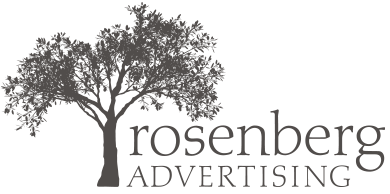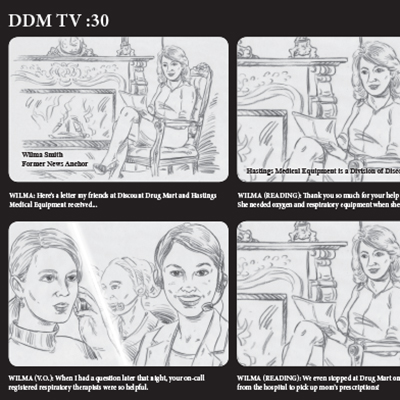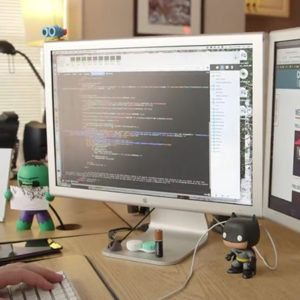Michelangelo (the artist, not the Ninja Turtle) famously wrote, when describing his sculpting technique, “I saw the angel in the marble and carved until I set him free.” If one substitutes the word story for angel, this is an apt description of how the creative team at Rosenberg Advertising approaches commercial concepting. Every client has a story they want to tell, and it is our job to discover that story and set it free.
What’s the story, morning glory?
Every commercial begins with a meeting—sometimes a conference call, but usually in person. The goal is for us to walk out of that meeting with a solid understanding of what, exactly, our client wants to accomplish with the commercial. What story do they want to tell? Are they selling something? An item? A service? What makes that item or service unique and special? Is it a brand awareness spot—are they selling themselves? Then what makes them unique and special? We like to gather as much information as possible, directly from the client, because that’s the best way to get a feel for not just the story they want to tell, but the story they don’t want to tell. Our job is to ask questions, and then listen, intently, to the answers.
We had a very successful retail client once tell us, as we were discussing an upcoming TV commercial, “I sell boxes. It doesn’t really matter what’s inside those boxes, because what I’m really selling is myself. I never let myself forget that.” That’s the kind of insight that makes the initial client meeting so important.
Brainstorm
Our next step after meeting with the client is a good old-fashioned brainstorm. These are informal and freewheeling, often fueled by bagels or pizza. We have a wall-size dry erase board in our conference room that’s perfect for capturing ideas as they’re thrown out. A brainstorm is a safe place, where no idea is too wild or impossible (although some ideas are worthy of laughter). In a good brainstorm session, you can feel the creativity arcing between us like an electric current.
Once we have several concepts that show promise, we start to whittle them down. Some ideas make it to the big board even though we know full well they’re not viable, and that’s okay. Often they act as a springboard for an idea that can work. This is where concerns regarding budget, timelines, talent, props, even background music get voiced. By the time we leave the conference room, the pizza is gone and our copywriter has a good handle on how to tell the client’s story.
To storyboard or not to storyboard?
Once our copywriter emerges from the dark depths of his basement office (okay, it’s actually a very nice basement office, with toys) with script in hand, the next step may, or may not, be to storyboard the commercial. Not every TV spot requires a storyboard. Some scripts are straightforward and easy to follow as written. There are several reasons we take the time to storyboard. The first, and perhaps most important, is to present the concept to the client in the best way possible. Some clients are visual thinkers, and for them a picture is truly worth a thousand words. A storyboard does the job that a script, no matter how well written, may not. We may also prepare storyboards as a tool to guide the production team, both to aid with accurate quoting and to help with planning the shoot. Finally, we sometimes do a storyboard for our own benefit, to see how the story flows, to make sure the individual scenes are working, that any graphics are integrated seamlessly; in other words, to be sure we are doing everything possible to set the story free.
The shoot
At this point, we are ready to plan for and execute the commercial shoot. But that’s the subject for another post.
Final thought
There is another Michelangelo quote that nicely bookends this post: “Lord, grant that I may always desire more than I can accomplish.” After a television commercial is completed, after the last edits have been made, the client has happily signed off and the spot has been uploaded to its final broadcast home, we always feel a sense of satisfaction for a job well done. That usually lasts until we see the spot in its natural habitat, on TV, when we start to think about all the things we could have done differently. And we think, next time we’ll do even better.




